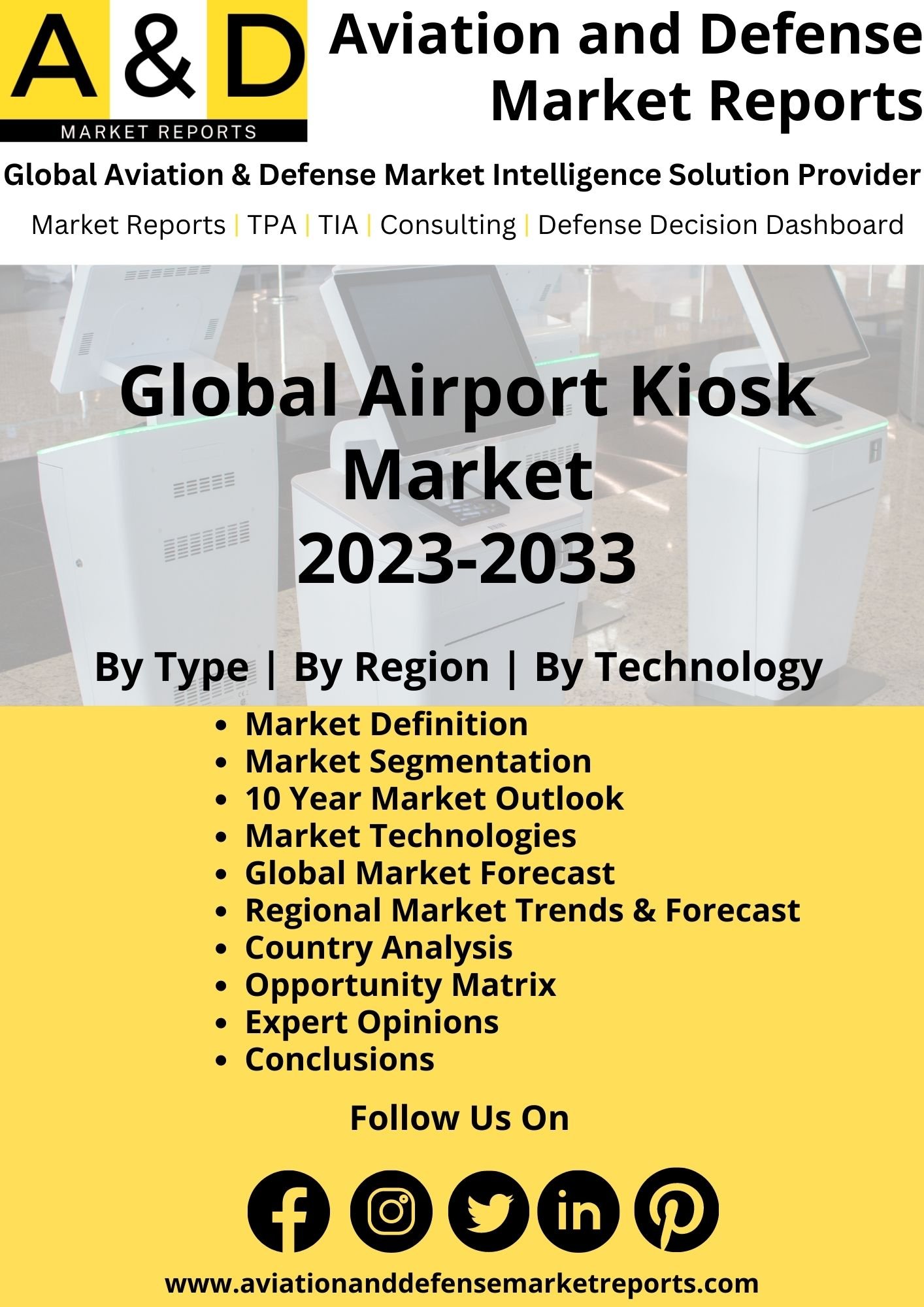Description
Airport KIOSK Market
Frequently Asked Questions of Global Airport KIOSK Market
Airport kiosks are self-service terminals or machines located within airports that provide a range of services and functions to passengers. These kiosks are designed to enhance convenience, efficiency, and the overall travel experience for passengers. Check-in kiosks allow passengers to complete the check-in process for their flights without the need for assistance from a staff member. Passengers can typically enter their booking information or scan their boarding pass, select seats, print boarding passes, and check their baggage. These kiosks help reduce wait times and streamline the check-in process.
Bag drop kiosks enable passengers who have already checked in online or at a check-in kiosk to independently drop off their checked baggage. Passengers can print bag tags, attach them to their luggage, and then place their bags on a conveyor belt or in a designated area for further processing. This self-service option can save time and reduce the need for direct interaction with airline personnel. Boarding Pass and Ticket Purchase Kiosks allow passengers to purchase tickets or print boarding passes if they have not done so before arriving at the airport. Passengers can enter their travel details, select flights, make payments, and obtain their boarding passes or e-tickets directly from the kiosk.
Information kiosks provide passengers with relevant airport information, such as terminal maps, flight information, gate assignments, directions to facilities or amenities, and general airport services. These kiosks help passengers navigate the airport more easily and find the information they need without seeking assistance from airport staff. Some airports feature self-service kiosks that allow passengers to browse and purchase products from airport shops or order food and beverages from airport restaurants. These kiosks can provide a convenient and efficient way for passengers to shop or order meals, especially during busy travel periods.
Major factors driving Airport KIOSK Market Growth
The market’s growth is driven by airports’ efforts to enhance passenger satisfaction, reduce queues, and optimize operational processes. Additionally, advancements in kiosk technology, such as touch-screen interfaces, biometric authentication, and integration with airport and airline systems, contribute to the market’s expansion.
Trends Influencing the Airport KIOSK Market Size
Advancements in airport kiosk technology have played a significant role in enhancing the passenger experience, improving operational efficiency, and expanding the functionalities of self-service kiosks within airport environments. The integration of user-friendly touch-screen interfaces has made airport kiosks more intuitive and easier to use. Passengers can navigate through options, select preferences, and input information by simply touching the screen, reducing the need for physical buttons or keyboards.
Modern airport kiosks offer a wider range of payment options, including credit cards, mobile wallets, and contactless payment methods. This allows passengers to make purchases or pay for services directly at the kiosk, reducing the need for cash transactions and improving convenience. Advanced data analytics capabilities are being incorporated into airport kiosks to gather and analyze passenger data. This helps airports and airlines gain insights into passenger behavior, preferences, and patterns, enabling them to tailor services, improve operational efficiency, and provide targeted marketing campaigns. These advancements in airport kiosk technology have transformed the self-service experience for passengers, allowing them to complete various tasks quickly and efficiently while reducing the reliance on airport staff.
Airport KIOSK Market Forecast & Dynamics
The airport kiosk market is expected to continue growing as more airports worldwide embrace self-service solutions to meet passenger demands for convenience, efficiency, and personalized experiences. The market projection comprises an extensive examination and assessment of the market, as well as its dimensions. The examination encompasses an evaluation of the market’s regional proportions, factors fueling its growth, limitations, and potential prospects. Moreover, the regional analysis encompasses an assessment of the market dimensions specific to each country.
Airport KIOSK Market Analysis for Recent Developments
Travelers heading out of Upstate South Carolina have a new, time-saving way to check in for their flights. In late May, Greenville-Spartanburg International Airport (GSP) announced the introduction of its new self-check-in kiosk service. These kiosks enable passengers to conveniently complete their flight check-in, print their boarding passes, and manage their luggage. With the implementation of these kiosks, passengers who opt for self-check-in no longer need to wait in line at airline ticket counters. For those utilizing the self-check-in service, participating airlines have designated a separate line for swift luggage drop-off. The self-check-in kiosks are positioned in the ticket lobby of GSP and are accessible to passengers flying with American Airlines, Delta Air Lines, and Southwest Airlines. Features may vary by airline. Additional airlines will be added to the service later in the year. To utilize the self-check-in kiosks, passengers will need to have their booking confirmation number and a valid form of identification.
Those flying out of Greenville-Spartanburg International Airport have a new way of checking in. The airport has launched a new self check-in kiosk service. The self check-in kiosks allow passengers to check in for their flight, print boarding passes, and check their luggage quickly and efficiently, according to a news release from the airport. The addition of self check-in kiosks is part of GSP’s ongoing efforts to provide passengers with a better airport experience, the release stated. With the new kiosks, passengers who choose self check-in will be able to conduct the entire check-in process without standing in line at airline ticket counters, making their travels faster and more convenient. Participating airlines will have a dedicated line for passengers to quickly drop off their checked luggage.
The global landscape of airport kiosks has experienced notable advancements, transforming passenger experiences and enhancing operational efficiency. Airport kiosks, equipped with cutting-edge technology, streamline check-in, baggage services, and other self-service processes. Advanced biometric authentication, such as facial recognition and fingerprint scanning, has been integrated into airport kiosks, providing secure and efficient identity verification for passengers. This contributes to expedited check-in and boarding processes.
Smart kiosks equipped with artificial intelligence (AI) and natural language processing enhance passenger interaction, offering personalized assistance, wayfinding, and real-time flight information. These features improve the overall passenger experience and reduce the workload on airport staff. Contactless technologies, including Near Field Communication (NFC) and QR code scanning, have become integral to airport kiosk operations. Passengers can use their smartphones for seamless check-in, boarding pass retrieval, and other transactions, minimizing physical touchpoints. Global standardization efforts and interoperability initiatives ensure consistency in airport kiosk functionalities, promoting a universal and user-friendly experience for travelers across different airports. This contributes to a more efficient and interconnected air travel ecosystem. The ongoing evolution of airport kiosks in 2023 underscores a commitment to leveraging technology for convenience, efficiency, and enhanced passenger services in the dynamic and fast-paced environment of air travel.





